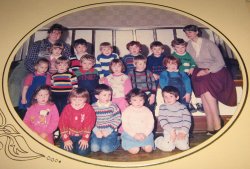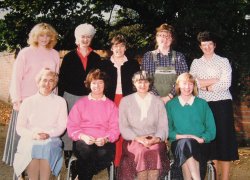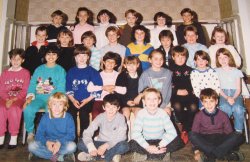
A little bit of insight into the origins of Forge, and also the very early days of integrated schools in Northern Ireland. Mary Connolly is founding Forge parent who also chaired the school's board of governors for a number of years.
Where did the idea for an integrated primary school come? Who was the first person to suggest it to you?
The whole idea of integrated education began with two women from Bangor, Betty Benton and Cecil Linehan. In the early 1970s they wanted to send their children to a school that was integrated. They were both Catholic and they wanted to arrange instruction for their children outside school, but the church refused. Over time other parents of both traditions became involved from around North Down and they founded ACT (All Children Together).
I had been teaching in England between 1973 and 1976 and when I came back a colleague of mine in the SEELB (South Eastern Education & Library Board, now subsumed into the Education Authority) told me about their campaign, not for new schools, but for more integration within the existing system. As time wore on however, they weren’t really getting anywhere and at one of their events a man called Tony Spencer, who had a child soon to transfer to secondary school, canvassed support for a new school, which was eventually to be Lagan College which began in 1981.
All this is documented elsewhere, and in much greater detail by Fionnuala O’Connor, but it is the background to a group of parents meeting together in south Belfast in 1984. Many of them were parents with children at Malone Primary School which was on the verge of closing, one of whom was Fionnuala. There was a meeting one evening, around the autumn time I think, in a community hall somewhere on Great Northern Street off the Lisburn Road. The idea was discussed for a while and there was an agreement to proceed with what was in effect the first transforming school.
Hazelwood I.P.S. also opened in September 1985, was there any overlap in preparations?
No, not really. The integrated movement was quite fragmented in a way, while people wanted integration there wasn’t always agreement about what that should look like. Around this time NICIE (Northern Ireland Council for Integrated Edcuation) had been formed and while ACT worked with the parents wanting to set up a school in south Belfast, NICIE worked with what would eventually be Hazelwood. I think I might have been chair of ACT at the time, but at any rate I became the link between ACT and the parents group. ACT gave a lot of help, but the parents took on the bulk of the fundraising, which was finally sorted by the Rowntree Trust which gave funding to various community projects. They underwrote the principal’s salary, but the money wasn’t actually in the bank when we appointed the principal! It all happened very late in the day, that appointment was at Easter time in 1985.
Given that this was a new venture, and most people would have seen it as a massive risk, and not least that there wasn’t even money in the bank yet, how big an uptake was there for the job of principal?
I think there were about six to ten people who applied, I can’t remember exactly but I think we interviewed six, and that was a pretty onerous process. They had to write an essay, they had to meet people and mingle with parents and children and then there were two interviews. The first principal was Mildred Kennedy, and then we appointed Judy Heaney not long after that. I think the next appointment was Frances Hastie but I can’t remember exactly. Mildred and Judy were definitely the first two.
What attributes did Mildred Kennedy bring to the job?
She had a lot of strengths. She came from a two teacher school in Castlerobin so she was used to working with mixed classes. She had also travelled abroad in Australia, I think, and so she had a broad experience of education. She had considerable energy, vision and commitment to what she was doing. She spent the whole summer of 1985 buying equipment for the school, she had a very practical head on her shoulders. I was very idealistic, sitting in a meeting before we started I said that transport would be provided and that the school would cater for children of all religions and those of none. But that was easy for me, Mildred was the person who actually had to make that work in practice, and when it came to organisation, she was well grounded.
What were the biggest difficulties to face at that time, just before the school opened?
There were so many meetings, and frequently they were long. Many of them went into six or seven hours, well into the early hours of the morning because people had ideals they wanted to see in practice, and it was hard to achieve a consensus sometimes. Very often what happened was that by one o’clock in the morning people were ground down and somebody gave in! Many discussions were, robust, shall we say!
What was the main issue?
Frequently it was religion. Some people felt it should be a part of school life and others felt it shouldn’t be in school at all, that it was a private matter for the family and church outside school. The name was also another big debate! I can’t remember any of the other possibilities but I always liked Forge because it had links to New Forge Lane, near where the school was, but also because it was snappy and it said something about what we wanted to achieve.
There were other ideals too, gender equality for example, we didn’t want the school to be just about Protestant and Catholic children being together, but that there would be general diversity; I was very enthused by the whole idea. I remember visiting a school just south of Dublin, an inter-denominational school where specific religious instruction actually took place after school and we looked carefully at that model.
How did you come to use the buildings of Malone Primary School?
Well Malone was closing down and many of the children attended the school. It was an available building. I don’t think legislation was yet in place for the department to provide somewhere, but I do remember threatening to protest outside Malone if we weren’t allowed to use it! Eventually the BELB (Belfast Education and Library Board) agreed and after a while ACT actually bought the site from them. A group of us did underwrite the whole project, we agreed that we would pay for the costs up to a certain point. I know that our house was part of the agreement, I didn’t tell my husband about it at the time, although I told him eventually!
 What opposition was there to the school?
What opposition was there to the school?
It’s hard to say. A lot of it was perceived, the churches were in some ways opposed, although not everyone. I know many people in ACT, which had a Christian basis, felt very aggrieved at the attitude of the churches. The authorities were very unsure in their approach, they were reluctant to keep open a small school and in general people were just uncertain about how it would all work in practice. I think many of the first parents faced criticism or concern from others in their family who saw it all as a giant risk.
Was there ever a time after the school opened when you thought, this isn’t going to survive?
Sometimes, but mainly over money, we lived hand to mouth for a few years, the first couple of years particularly. The IEF (Integrated Education Fund) was just being set up and that made things much easier. But then in the late 1980s, Michael Rea, who was a senior board officer in the education board encouraged the school to become ‘controlled’. There was obviously a lot of discussion about that but it’s something that Mildred Kennedy was very sure about. Being ‘controlled’ by the education board did mean that we ceased to be an independent school, but funding was assured and that meant greater financial security for staff.
One last question, as a parent of children who attended integrated schools what do you feel has been their greatest success?
Friendships. Lifelong, or at least long term friendships. Both of my boys went to Lagan and both still have friends from that time. It’s not impossible to develop friends from a different community if you go to a Catholic school, or a state school, but it’s much easier if you go to an integrated school.
Mary Connolly is now semi-retired after teaching in both Northern Ireland and England and working for the South Eastern Education Board. She served as a Forge governor until 2005. The photographs used above were taken in 1988, three years after Forge started. One of the pupils pictured has since sent her own children to Forge.
If you would like to know more, Fionnuala O'Connor wrote about the story of integrated schools in Northern Ireland in a book called "A Shared Childhood" published by Blackstaff Press. You can find out more about the book here.




